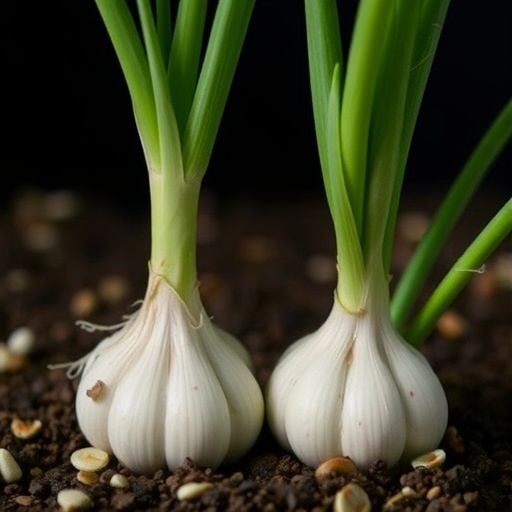In an exciting new study on the endophytic microbiota of garlic bulbs, researchers have uncovered the remarkable symbiotic relationships between plants and microorganisms. These findings have significant implications for agriculture and sustainable farming practices, potentially ushering in a new era of plant growth promotion. The endophytic microbiota, which reside within plant tissues without causing disease, can play a crucial role in enhancing plant health, growth, and yield. This discovery sheds light on the intricate partnerships that exist in nature and the potential for harnessing these relationships for agricultural benefit.
The research team, led by Quezada-García, embarked on an exploration of the microbial communities associated with garlic plants. By meticulously isolating and characterizing various endophytic bacteria, they sought to identify those species that exhibit plant growth-promoting characteristics. The study highlights the diversity of these microorganisms and their potential roles in enhancing plant development through various mechanisms, such as nutrient solubilization, production of phytohormones, and biocontrol of plant pathogens.
One particularly astonishing finding from this research is the ability of certain endophytic bacteria to produce auxins, a class of phytohormones that play a pivotal role in regulating plant growth and development. These hormones can stimulate root elongation and promote lateral root formation, thereby improving nutrient uptake and overall plant vigor. As the global population continues to rise, the need for innovative and sustainable agricultural practices becomes increasingly crucial. Leveraging the capabilities of beneficial microbes could revolutionize how we approach crop production.
Moreover, the study explores the role of endophytes in enhancing resistance to abiotic stressors, such as drought and salinity. The presence of specific bacterial strains within the garlic bulbs seems to bolster the plant’s ability to withstand challenging environmental conditions. This resilience is especially important in the face of climate change, where unpredictable weather patterns pose a significant risk to agricultural yields globally.
In addition to promoting plant growth, many endophytic bacteria also exhibit biocontrol properties. This means they can inhibit the growth of pathogens that threaten plant health, providing an organic approach to pest management. The research underscores the potential of these beneficial microbes as a natural alternative to chemical pesticides, aligning with the growing interest in sustainable and eco-friendly agricultural practices.
Throughout the study, the researchers employed advanced genomic techniques to identify the microbial communities within the garlic bulbs. By sequencing the DNA of these microorganisms, they were able to create a comprehensive map of the microbial diversity present in this unique environment. This cutting-edge approach not only enhances our understanding of plant-endophyte interactions but also lays the groundwork for future studies aimed at optimizing these relationships for agricultural benefit.
One of the critical implications of this research is its potential to influence agricultural policy and practices. As farmers and agricultural scientists seek to enhance crop productivity while minimizing environmental impacts, the findings could serve as a blueprint for integrating beneficial microbes into cultivation strategies. By promoting microbial diversity within agricultural systems, there is a promising pathway toward achieving higher yields without compromising the health of our ecosystems.
In light of the ongoing challenges presented by soil degradation and declining fertility, the role of microbial communities in promoting plant health cannot be overstated. The research reinforces the idea that healthy soils, teeming with diverse microbial life, are foundational to sustainable agriculture. By investing in microbial research and development, we can unlock new potential for soil health and, consequently, food security.
The findings from this study also emphasize the importance of preserving plant biodiversity. As researchers delve deeper into the microbial life associated with various plant species, the interconnectedness of ecosystems becomes increasingly apparent. Protecting diverse plant species will inherently support a robust microbiome, which in turn supports agricultural productivity and resilience.
In conclusion, the study conducted by Quezada-García and colleagues presents groundbreaking insights into the role of endophytic microbiota in garlic bulbs. These microorganisms hold incredible potential for enhancing plant growth and resilience, particularly in the face of climate change and environmental challenges. By fostering our understanding of these relationships and integrating them into agricultural practices, we can pave the way toward a more sustainable and productive future for crop production.
This research serves as a clarion call for scientists, farmers, and policymakers alike to recognize the value of microbial diversity in agriculture. As we look ahead, it is imperative that we embrace the lessons learned from nature to cultivate a harmonious balance between agricultural productivity and environmental stewardship.
In summary, the exploration of plant growth-promoting endophytic microbiota from garlic bulbs reveals a captivating interplay of life that could transform agricultural practices. As we continue to unravel the complexities of these relationships, the possibilities for enhancing food security and promoting sustainable farming methods expand exponentially.
Subject of Research: Endophytic Microbiota in Garlic Bulbs
Article Title: Plant growth-promoting endophytic microbiota from garlic bulbs.
Article References:
Quezada-García, G., Zelaya-Molina, L.X., Chávez-Díaz, I.F. et al. Plant growth-promoting endophytic microbiota from garlic bulbs.
Int Microbiol (2025). https://doi.org/10.1007/s10123-025-00724-w
Image Credits: AI Generated
DOI: https://doi.org/10.1007/s10123-025-00724-w
Keywords: Endophytes, Plant Growth Promotion, Microbial Diversity, Sustainable Agriculture, Phytohormones, Climate Resilience.




